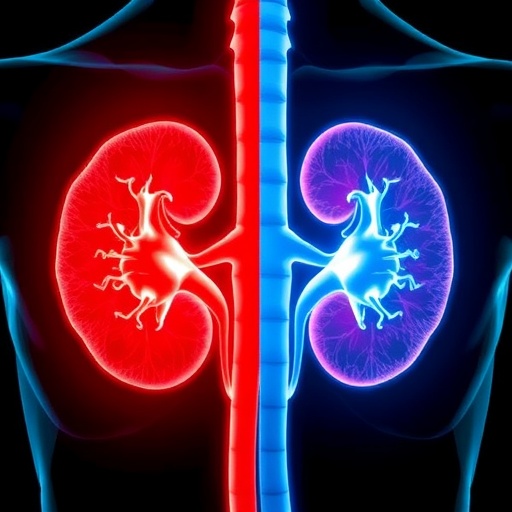In the ever-evolving journey to unravel the complexities of cellular metabolism and its systemic implications, a groundbreaking study has illuminated a fascinating nexus between mitochondrial dysfunction, metabolic intermediates, and the phenotypic fate of brown adipocytes. This research, recently published in Nature Metabolism, decisively links the accumulation of 2-hydroxyglutarate, a metabolite long-associated with oncogenic processes, to a process intriguingly termed as “whitening” of brown adipose tissue, accompanied by subtle yet impactful alterations in nuclear mechanics. The implications of these findings ripple across our understanding of energy homeostasis, metabolic diseases, and even the intricate architecture of the cellular nucleus.
Brown adipose tissue (BAT) has been revered within the scientific community for its thermogenic prowess, enabling mammals to dissipate energy as heat, thereby contributing to energy balance and protection against obesity. Unlike white adipose tissue, which primarily stores energy in the form of lipids, BAT contains densely packed mitochondria and specialized uncoupling proteins, granting it the unique ability to burn calories. However, the plasticity of brown adipocytes, especially under pathological or stressed states marked by mitochondrial compromise, remains a critical enigma. The present work reveals how mitochondrial dysfunction triggers a cascade culminating in the accumulation of 2-hydroxyglutarate (2-HG), a metabolite that orchestrates the phenotypic transformation of brown adipocytes.
At the heart of this cellular reprogramming lies the mitochondrial failure that disrupts the tricarboxylic acid (TCA) cycle and associated bioenergetics. Mitochondria, beyond their classical role in ATP production, generate a myriad of metabolites that function as signaling molecules and epigenetic regulators. When mitochondrial integrity falters, the resultant metabolic imbalance leads to the abnormal elevation of 2-HG, a metabolite normally present at trace levels. Elevated 2-HG has been extensively studied in cancer contexts, especially gliomas and leukemias carrying mutations in isocitrate dehydrogenase (IDH) enzymes. Yet, its role in adipocyte biology and systemic metabolism had been elusive until now.
.adsslot_HQTmDEnBlI{width:728px !important;height:90px !important;}
@media(max-width:1199px){ .adsslot_HQTmDEnBlI{width:468px !important;height:60px !important;}
}
@media(max-width:767px){ .adsslot_HQTmDEnBlI{width:320px !important;height:50px !important;}
}
ADVERTISEMENT
The authors employed a combination of cutting-edge metabolomic profiling, super-resolution microscopy, and biophysical assessments to unravel how 2-HG orchestrates its effects at the interface of cellular metabolism and nuclear structure. Mitochondrial defects induced pharmacologically or genetically elevated intracellular 2-HG, which in turn initiated a process akin to the “whitening” phenomenon, where brown adipocytes lose their thermogenic identity and acquire white fat-like characteristics. This conversion is strikingly coupled with a measurable softening of the nuclear envelope, a biophysical change with extensive ramifications for gene expression and chromatin organization.
Investigation into the nuclear mechanical properties revealed that mitochondrial distress impacts lamin A/C and other nuclear structural proteins, altering nuclear stiffness. This softening correlates with epigenetic remodeling, likely mediated through 2-HG-dependent inhibition of α-ketoglutarate-dependent dioxygenases, including histone and DNA demethylases. These epigenetic enzymes are known to be exquisitely sensitive to metabolic cues, and their inhibition manifests as altered chromatin accessibility and transcriptional rewiring. Thus, mitochondrial health not only governs cellular metabolism but also directly signals to chromatin architecture, dictating cellular fate and function.
The whitening of brown adipocytes diminishes their capacity for heat generation, with profound implications for systemic metabolism, particularly in energy expenditure and insulin sensitivity. This newly uncovered axis raises tantalizing questions about the role of mitochondrial metabolites as systemic signaling entities governing adipose tissue plasticity and metabolic health. Could the dysregulation of mitochondrial function and consequent metabolite shifts be a previously underappreciated driver of metabolic diseases such as obesity and type 2 diabetes? These findings suggest that restoring mitochondrial function or targeting 2-HG accumulation might reverse the detrimental white-like phenotype in BAT, opening new avenues for therapeutic intervention.
Beyond metabolism, the study pioneers a conceptual advance by directly linking mitochondrial metabolic pathology to changes in nuclear mechanical properties – a frontier previously explored mainly within the context of aging and disease. The nuclear envelope’s mechanical landscape emerges as a critical integrator of metabolic inputs, converting mitochondrial signals into structural and functional nuclear adjustments. The authors meticulously demonstrate that 2-HG accumulation leads to the downregulation of nuclear stiffness, altering mechanotransduction pathways and potentially modifying the cell’s response to environmental stress.
Methodologically, the integration of atomic force microscopy and live-cell imaging allowed the authors to quantify nuclear stiffness with exceptional precision, correlating these measurements with real-time metabolite fluxes. This interdisciplinary approach underscores the necessity of combining biophysical and biochemical methods to decipher the complexity of intracellular signaling networks. Moreover, the employment of brown adipocyte-specific mitochondrial manipulation models solidifies the causal link between mitochondrial dysfunction, 2-HG accumulation, and adipocyte phenotypic shifts, moving beyond mere correlation.
From a translational standpoint, these insights could revolutionize strategies to manipulate brown fat activity in metabolic disorders. Current approaches to activate BAT thermogenesis primarily focus on adrenergic signaling; however, this study suggests targeting mitochondrial metabolic pathways and metabolite signaling as a promising alternative. By preventing mitochondrial dysfunction or scavenging 2-HG, it may be possible to preserve or restore the thermogenic phenotype of BAT, enhancing whole-body energy expenditure and metabolic health.
Furthermore, the intriguing crosstalk between mitochondria and nuclear mechanics invites exploration of similar mechanisms in other cell types where mitochondrial impairment is central, such as neurons in neurodegenerative diseases or cardiomyocytes in heart failure. The concept that mitochondrial metabolites dynamically remodel nuclear architecture could be a unifying theme driving diverse pathophysiological processes.
The study also touches upon the potential impact of these findings on our understanding of aging. Mitochondrial decline is a hallmark of aging, and nuclear mechanical integrity is compromised in aged cells. The demonstration that mitochondrial metabolites directly modulate nuclear mechanics could thus provide a mechanistic underpinning for age-related functional decline in adipose tissue and other organs. Interventions aimed at maintaining mitochondrial function might therefore have far-reaching anti-aging effects beyond energy metabolism.
Importantly, the reported phenomenon of nuclear softening is reversible, as indicated in experiments where restoration of mitochondrial function normalized nuclear stiffness and reestablished brown adipocyte identity. This reversibility highlights the plastic nature of the nuclear-cytoplasmic axis and offers hope that metabolic and structural cellular derangements are not irrevocably fixed, but amenable to therapeutic modulation.
This study also redefines 2-hydroxyglutarate beyond its traditional role as an oncometabolite. By establishing 2-HG as a metabolite with broad influence over cellular identity, energy metabolism, and nuclear mechanics, it triggers a paradigm shift that will catalyze future research into the diverse roles of metabolic intermediates as multi-dimensional regulators of cell fate.
In conclusion, the work by Kaul, Isermann, Senft, and colleagues delivers a transformative perspective into how mitochondrial dysfunction propagates metabolic and structural reprogramming of brown adipocytes. By positioning 2-hydroxyglutarate as a pivotal mediator linking mitochondrial metabolism to nuclear softening and adipocyte whitening, this research opens up vast new territories for investigation with implications spanning metabolism, epigenetics, mechanobiology, and potential clinical translation. As the fields of cellular metabolism and nuclear biomechanics converge, the implications for understanding and treating metabolic diseases, aging, and beyond could be profound and far-reaching.
Subject of Research: Mitochondrial dysfunction-induced 2-hydroxyglutarate accumulation drives whitening of brown adipocytes linked to nuclear softening.
Article Title: 2-hydroxyglutarate mediates whitening of brown adipocytes coupled to nuclear softening upon mitochondrial dysfunction.
Article References:
Kaul, H., Isermann, L., Senft, K. et al. 2-hydroxyglutarate mediates whitening of brown adipocytes coupled to nuclear softening upon mitochondrial dysfunction. Nat Metab (2025). https://doi.org/10.1038/s42255-025-01332-8
Image Credits: AI Generated
Tags: 2-hydroxyglutarate and brown fat whiteningbrown adipose tissue thermogenesisbrown fat and calorie burningcellular metabolism and nuclear architectureenergy homeostasis and metabolic diseasesimplications of brown fat plasticitymetabolic intermediates in obesitymitochondrial dysfunction and energy metabolismNature Metabolism research findingsnuclear mechanics in adipocytesoncogenic metabolites and metabolismphenotypic fate of brown adipocytes





